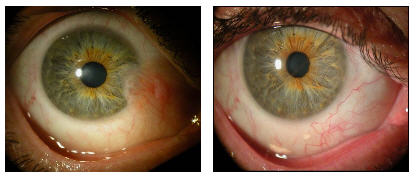As indicated, Dr. Jovkar can remove your pterygium tissue surgically in an outpatient setting under local or topical anesthesia.
In order to help the area around the pterygium heal, Dr. Jovkar will treat the surface of your eye by covering the area where the pterygium was removed with transplant material. Dr. Jovkar employs a sutureless technique during these procedures which provides faster healing and superior comfort.

Before and After Pterygium Surgery (Pterygium excision with antimetabolites and amniotic membrane [Amniograft] transplantation)
Despite proper surgical removal, pterygium or pinguecula may recur. Dr. Jovkar uses the most advanced techniques in treating these conditions, including the use of tissue transplantation, antimetabolites, and tissue-based glues.
After the surgery, the eye may be patched overnight. Topical antibiotic and anti-inflammatory drops and/or ointments will be used to help with healing. Dr. Jovkar will follow up with you regularly after the surgery. Most people can resume full activity within a few days. The eye typically heals within two to three weeks.
The most common complication of pterygium surgery is the chance of recurrence which is significantly reduced using the techniques described above. It is of paramount importance to follow Dr. Jovkar’s instructions regarding the use of drops and during post-operative follow-up visits.
